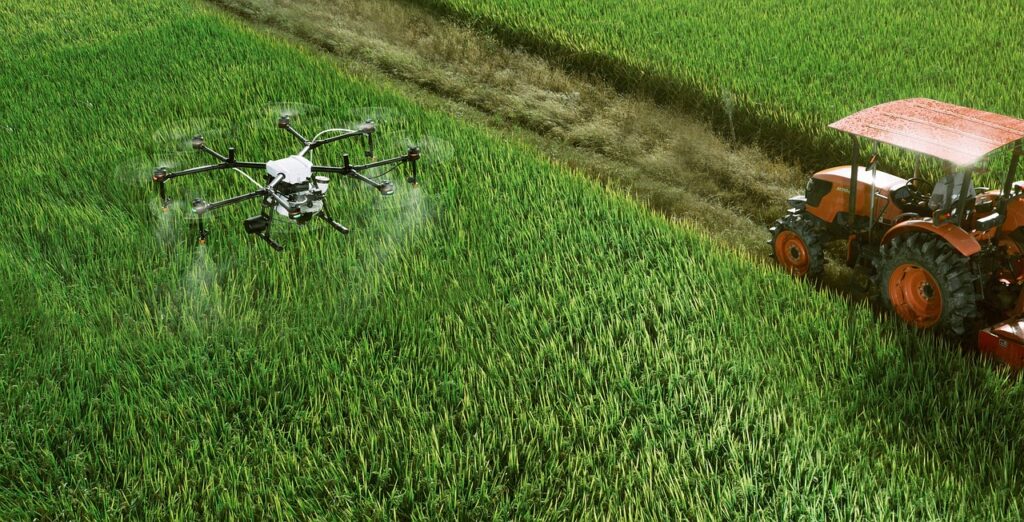Is there a perfect time to send your spraying drones over the crops? The quick answer is yes! Timing is everything in drone spraying.
Spraying at the wrong time of the day or in the wrong season may harm pesticide absorption or drift management.
Should I choose early morning or late evening? It is not about the weather. It’s all about making smart decisions that increase yields by reducing waste. Knowing when to spray can help you save time & money in the long run.
We have compiled the best times of day and seasons for drone spraying to increase the effectiveness of every flight!
What is the Best Time of the Day for Drone Spraying?
Spraying drones are most effective at certain times of day. Choosing the right time can make your spray more efficient with less chemical waste.
The early morning hours are often the best time for drone spraying. You can be certain that your spray will reach the crops without drifting away or evaporating too quickly.
Another fantastic time to go is between the late afternoon & early evening. You will have better visibility than in the early morning while flying manually, along with the same benefits.
It is not best to spray around midday when the sun is at its peak. Drone batteries of spraying systems can be stressed in hot environments, which can increase evaporation or drift. You need to time your spray correctly to fly efficiently.
How Wind Affects Drone Spraying Efficiency?
Most of us think wind is harmless, but drone spraying is sensitive to wind. Optimal wind speeds range from 2 to 6 mph (3 to 10 km/h), which is just the right amount of wind to keep things moving forward without being too powerful to scatter your spray.
It is a big mistake to spray in high winds. Drift is a significant problem because it causes chemicals to fall far from where they are needed. This can waste chemicals or damage local crops. That is dangerous as well as ineffective.
Agricultural drones handle wind better than traditional spraying machinery. They were able to remain on track because of their advanced GPS or stabilising technology.
Checking the local wind conditions before takeoff is a good idea. This is because even the best drones cannot withstand high winds. It is important to note that spraying on a calm day will result in more accurate spraying.
Best Seasons for Drone Spraying by Crop Type
It is essential to match the crop’s growth stage with the right season to maximise the benefits of drone spraying. Drones make it possible to precisely focus care on the various crops that require different treatments at different times of the year.
Spring
Spring is the ideal time to apply pre-emergent herbicides or control early-stage pests.
Summer
The crops need more assistance as they develop rapidly in the summer. This is when drones are great for spraying fertilisers or pesticides based on specific growth stages.
Fall
Fall is perfect for desiccation or drying out crops in preparation for harvest.
Winter
Winter is the perfect time for dormant spraying to prepare for a healthy new season.
Let us look at the best spraying time for crops.
| Crop | Spring | Summer | Fall | Winter |
| Corn | Herbicide | Fertiliser, Pesticide | Desiccation | – |
| Soybeans | Pest Control | Fungicide, Growth Spray | Disease Control | – |
| Wheat | Pre-emergents | Fungicide, Boosters | Desiccation | – |
| Vineyards | – | Fungicide, Nutrition | Pest Management | Dormant Spray |
| Orchards | – | Pest/Fungus Management | Disease Treatment | Dormant Spray |
When Not to Spray with Drones?
Timing your drone spraying is as essential as choosing the right chemicals. Wasted resources or inadequate crop coverage might result from spraying in the incorrect conditions. These are some situations where you should not use drones for spraying.
Rainy Days
Never spray during or just before raining. Rain will wash away the spray before the crops can absorb it. Hence, your hard work will be for nothing.
High Winds
Strong winds can cause chemical drift. It has the dual effect of reducing precision and also harming surrounding crops. Even advanced drones can lose control in windy environments.
Extreme Heat
The spray can evaporate before it reaches the crop if the temperature is too high. Less effectiveness or more chemical waste can result from this.
Poor Visibility
Drones cannot use GPS or visual navigation unless the sky is clear. Accidents or inadequate coverage can happen while flying in poor visibility.
The Final Thoughts
Choosing the right time of day & season is the secret of getting the best results from your drone spraying. You can get the most out of your spray by timing it for either early morning or late afternoon.
It is very beneficial to time your sprays such that they coincide with your crop’s growth cycle. The key is to balance with nature rather than against it.
Applying the right amount of spray requires careful monitoring of the weather or crop requirements. Plan to let your drone do efficient work for you at the right moment!



